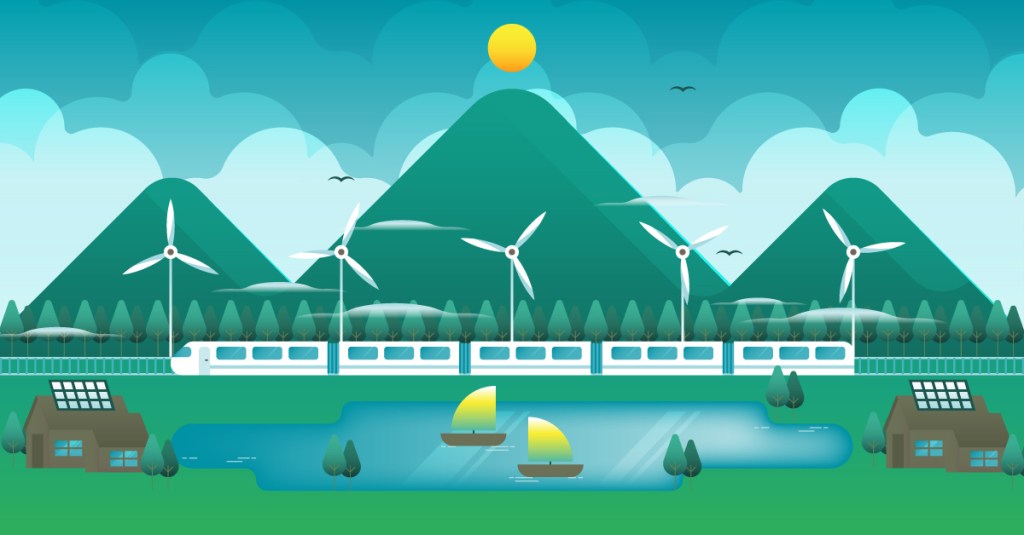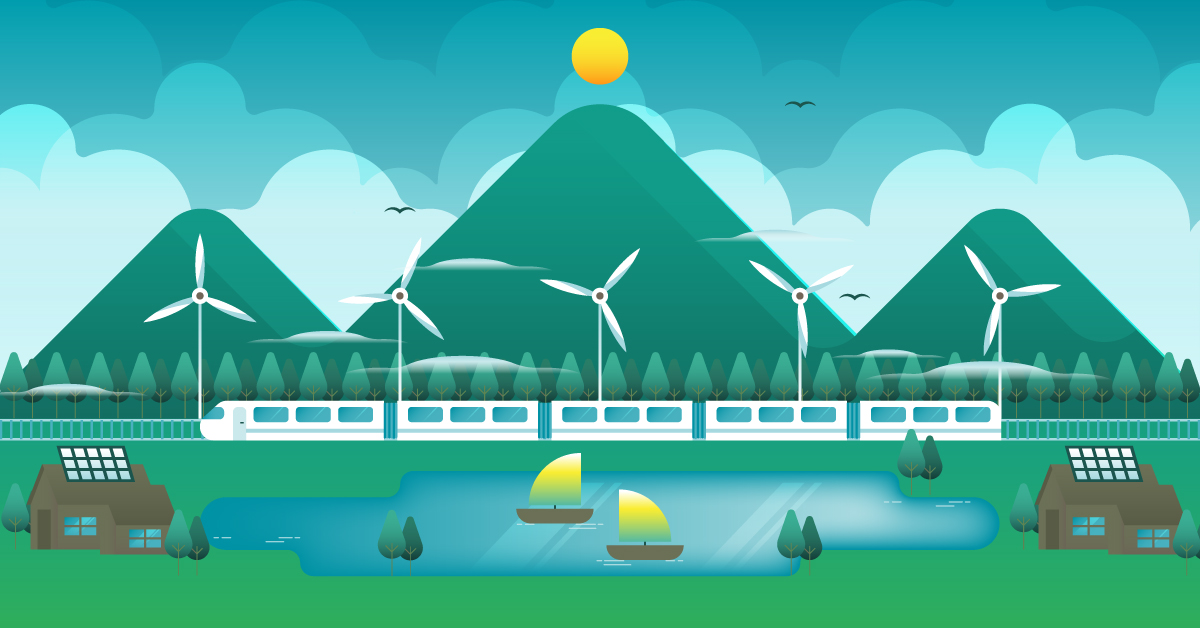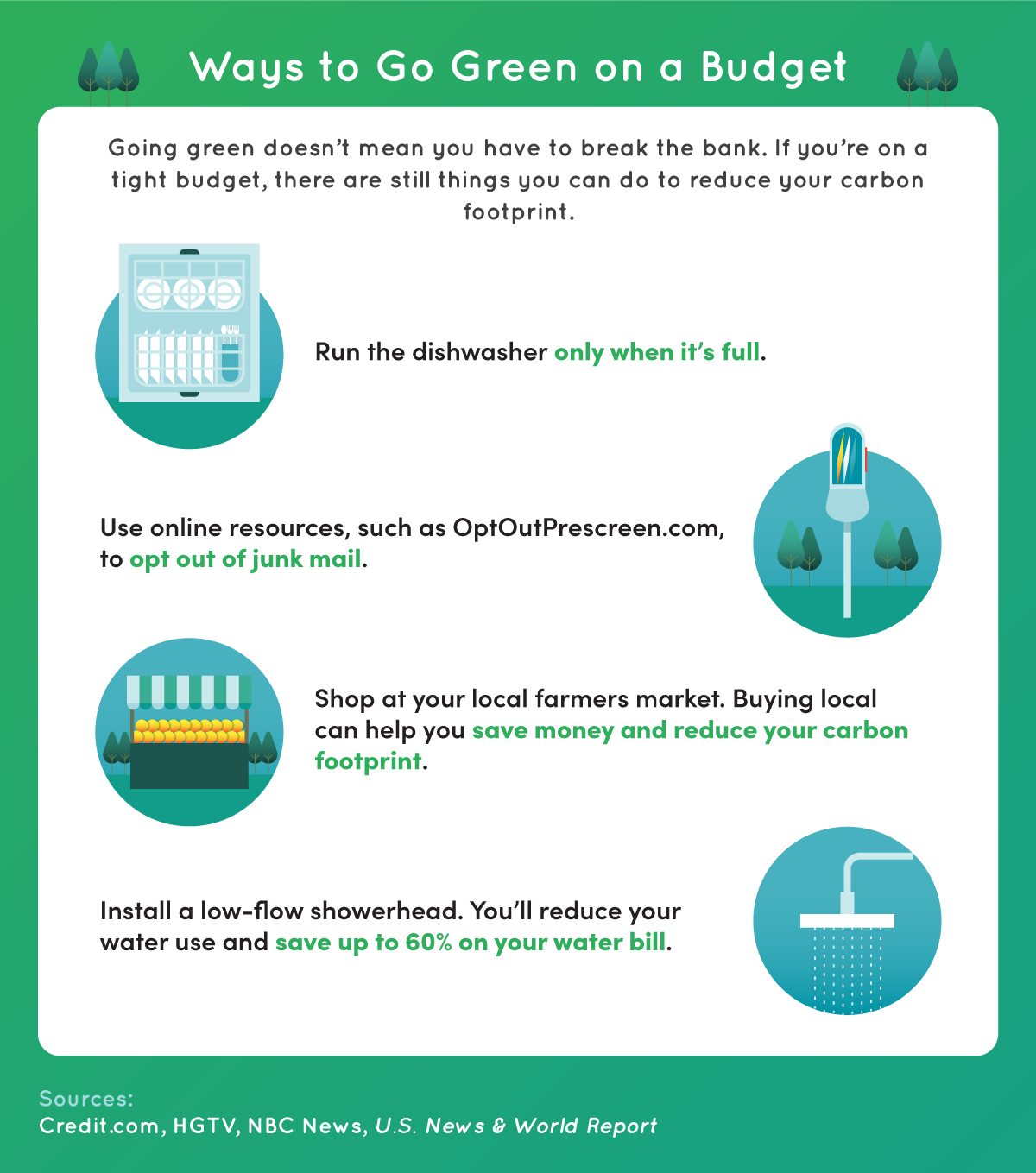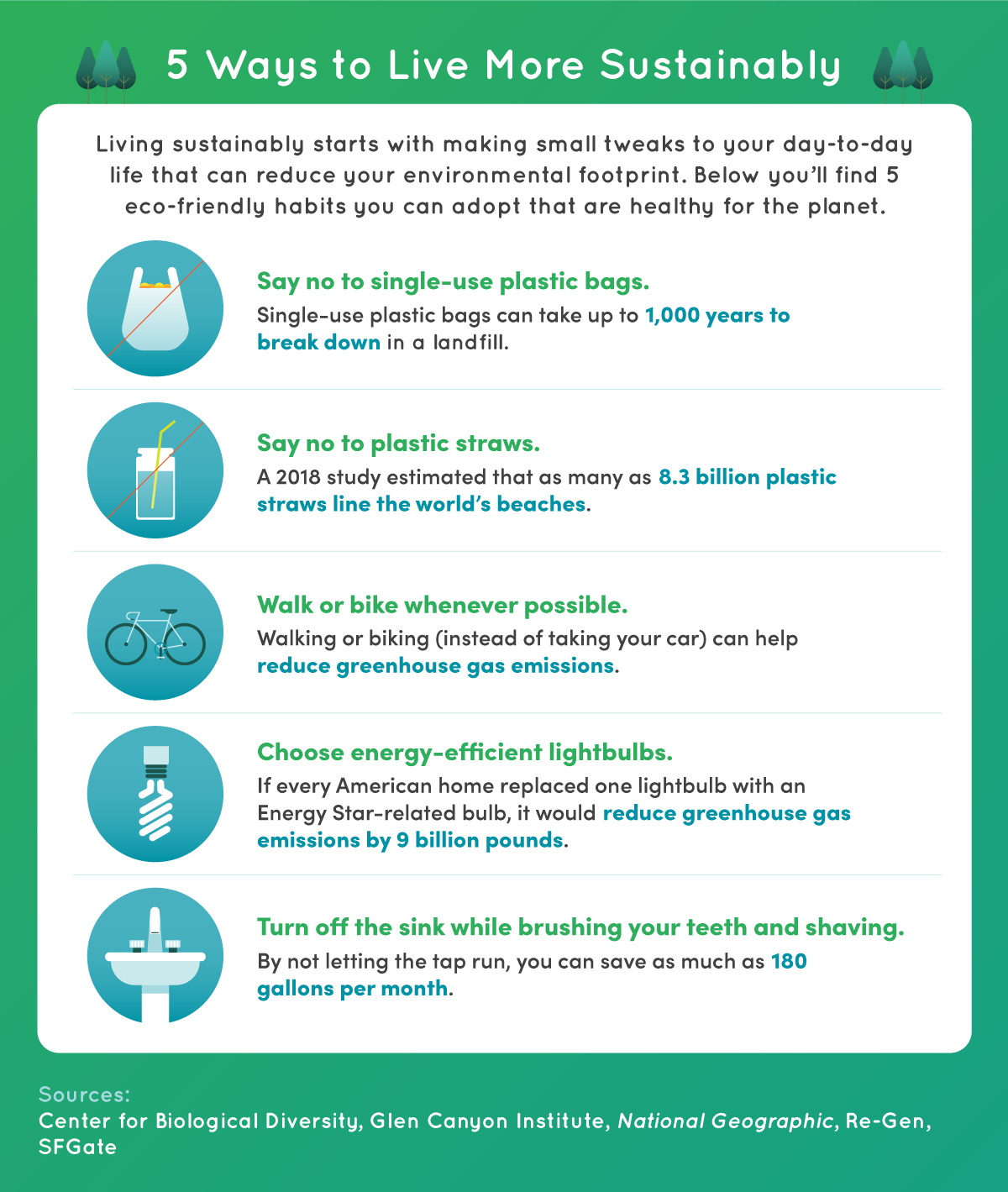What Is Sustainable Living? Ideas and Innovations to Help Get You Started


Sustainable living is about more than just recycling. It encompasses a wide range of actions that people and businesses can take to reduce their environmental impact, such as using less water, creating less waste, and switching to renewable energy sources.
Positive changes in how humans live their lives, even for short periods of time, can have a positive impact on the environment. For example, researchers in New York reported carbon monoxide emissions measured in March 2020 were 50% lower than normal levels for the month according to the BBC. In Europe, satellite images of Venice, Italy, showed that the lockdown led to fewer boats in the city’s famous canals, and residents reported clearer water. In India, residents in Punjab said that the reduction in air pollution helped them see the Himalayas for the first time in decades.
Individuals who want to live a more sustainable lifestyle and have a longer-lasting impact on the environment should know there are various ideas for sustainable living that they can incorporate in their day-to-day lives. It’s also worth noting that numerous career paths are available to those who want to pursue jobs in this field.
Definition of Sustainable Living
Sustainable living is the practice of making conscious lifestyle choices that reduce a person’s impact on the environment. Individuals who embrace sustainable living philosophies aim to reduce their carbon footprint and conserve Earth’s resources. For example, some people bike or take public transportation to work, because these modes of transport reduce their carbon emissions. Others have stopped using single-use plastic grocery bags in favor of multi-use cloth bags as part of their sustainable living definition.
Sustainable living advocates aim to live in ways that are less taxing on Earth’s natural resources. Sustainable living shouldn’t be confused with the zero waste movement, which is more narrowly focused on reducing landfill pollution. Zero-waste advocates pursue this goal by taking steps to reduce or eliminate the amount of trash that individuals and families produce.
How Sustainable Living Can Slow or Stop Climate Change
There are a number of ways that sustainable living ideals can help slow or stop climate change. For example, most of the world’s leaders have agreed that certain sustainability models, such as reducing carbon emissions, must be implemented more broadly. This consensus led to the drafting and passage of the 2016 Paris Agreement, an accord among global nations to take action to limit global warming.
Reducing animal agriculture can also contribute to a reduction in greenhouse gases. According to a recent analysis of studies on vegan, vegetarian, and omnivorous diets published in Sustainability, meat and dairy production are expected to increase by 58% and 73%, respectively, between 2010 and 2050. Considering the U.S. Environmental Protection Agency (EPA) estimates that livestock farms accounted for 9.9% of the nation’s greenhouse gas emissions in 2018, the forecast production spike could have a significant impact.
This is underscored by a 2018 study published by The Lancet Planetary Health, which reports that widespread replacement of animal source foods with plant-based foods could reduce greenhouse gas emissions by as much as 84%.
How to Live Green on a Budget
Going green doesn’t have to be expensive; there are lots of ways to live green on a budget. In some cases, improving sustainability can even save money. For example, reducing energy consumption by turning off lights, unplugging appliances when they’re not being used, and washing clothes on cold-water settings can reduce monthly utility costs.
Other actions individuals can take to support sustainable living and potentially save money include choosing cloth instead of disposable diapers, sponges instead of paper towels, and coffee mugs instead of plastic foam cups. Individuals can also shop at thrift stores and garage sales to reduce waste and lower expenses.

How to Make Your Household More Environmentally Friendly
Scientists estimate that billions of tons of carbon dioxide are pumped into Earth’s atmosphere every year. Making households more eco-friendly is one of many ways to help reduce carbon dioxide emissions. For example, it’s been estimated that Americans throw away 80 billion pounds of food each year. Cutting food waste reduces agricultural requirements and the amount of food that’s sent to landfills, therefore reducing agriculture- and landfill-generated emissions.
Other ways to make your home more eco-friendly include recycling, shifting to energy-efficient appliances, planting trees, reducing water leaks, and taking shorter showers. Individuals can also make homemade cleaning products from common household items, such as lemons, baking soda, vinegar, and salt to reduce chemical exposure and pollution.
What Is Sustainable Living? 7 Lifestyle Examples
Individuals who find themselves wondering what sustainable living is may be interested to explore simple actions they can take to support a healthier environment. Individuals who want to live more sustainably can do so in the following ways.
Conserve Water
Scientists estimate that 71% of Earth’s surface is covered in water, yet only 3% of the planet’s water is safe to drink. Of that 3%, 2.5% is contained beneath the surface in glaciers and ice caps, or in the atmosphere, which leaves 0.5% available for drinking. That being the case, water conservation is a cornerstone of sustainable living. The benefits of conserving water include reduced water and energy bills and improved water supply reliability during droughts.
Common ways that people conserve water include switching to low-flow toilets and shower heads, checking for leaks, and turning off running water while doing the dishes or brushing their teeth. Other efforts may include asking local authorities for a water audit, installing rain barrels, or adding rain sensors to irrigation systems.
Support Local Farmers
Buying local produce is good for the planet. For example, whereas strawberries sold in big-box stores often come in single-use plastic boxes, strawberries sold at farmers markets tend to have limited packaging. Buying local reduces waste and fossil fuel use from transportation.
Eat Organic Foods
Organically grown foods promote environmental sustainability. Data suggests that organic farming rebuilds soil health and prevents harmful chemicals from polluting water supplies. Organic farming also supports local wildlife, as farmers who don’t use pesticides often have greater biodiversity of plants, insects, and microbes on their farms.
Eat a Plant-Based Diet
Limiting the consumption of meat, eggs, and dairy products can help individuals reduce their carbon footprint. The Economist reports that if more people decided to eat vegan for two-thirds of meals, global carbon emissions would be cut by nearly 60%. Reducing dairy consumption can be beneficial for the environment because it’s estimated that dairy farms generate roughly 40% of all the methane gas that’s produced each year.
Start Composting
Numerous environmental benefits are associated with composting, according to the EPA. Composting transforms yard waste and food scraps into a product that can be used to improve soil quality, reducing reliance on chemical fertilizer.
The EPA further states that composting improves water retention in soils and reduces the amount of organic waste that’s shipped to landfills. The latter is important because when organic waste is disposed of in landfills, it releases methane gas (a greenhouse gas) as it breaks down, whereas methane emissions are significantly reduced when organic waste is broken down via composting due to higher oxygen levels.
Recycle
Recycling is an important component of sustainability. In addition to reducing the amount of waste that’s sent to incinerators and landfills, recycling helps conserve natural resources, such as timber. The International Union for Conservation of Nature (IUCN) estimates that roughly 8 million tons of plastic waste ends up in the world’s oceans every year. Recycling products made from plastics, such as bottles and single-use bags, helps reduce marine plastics.
Local authorities typically have different rules about what can be placed in recycling bins, but some common guidelines include:
- Make sure recyclable materials — including glass, aluminum, tin, and plastic containers — are thoroughly cleaned and dried.
- Include only clean paper, cardboard, and boxboard.
- Don’t recycle plastic bags (but do take them to the grocery store for recycling).
- Include rigid plastics labeled with the numbers 1 through 7, but not utensils or straws.
- Don’t recycle combined materials, such as paper cups with plastic coating.
Shop Secondhand
Numerous environmental benefits are associated with buying secondhand clothes. Clothing that’s produced in factories results in greenhouse emissions, and these emissions can be substantial. This is noted in a 2019 article on Medium, which found that it takes an estimated 70 million barrels of oil to produce all of the polyester that the world consumes each year. Further, the wastewater that’s produced when fabrics are dyed often winds up in water systems. Buying used clothes also prevents them from winding up in landfills.

6 Sustainable Living Innovations That Are Helping to Save the Planet
There have been various innovations in sustainable living in recent years, such as the invention of edible utensils and edible water bottles, and an increase in the number of buildings that have been Leadership in Energy and Environmental Design (LEED) certified by the U.S. Green Building Council (USGBC). Below are just a few of the many sustainable living innovations that have made a positive impact on the planet.
Green Building Initiative
The Green Building Initiative is a 501(c)(3) nonprofit organization that’s working to accelerate the adoption of green building best practices, such as the installation of solar panels and the use of eco-friendly building materials. Targeting architects, developers, and government agencies, the organization strives to expand energy-efficient, sustainable construction.
LEED-Certified Cities
The USGBC has been using the LEED rating system since 1998. In 2016, the USGBC took the certification process one step further by launching LEED for Cities and LEED for Communities, which asked cities and communities to set goals and implement strategies designed to promote green and sustainable living.
In November 2019, Atlanta became the 100th LEED-certified city. Certification is provided based on various sustainability outcomes in areas such as energy, waste, water, and transportation.
Powerhouse Brattørkaia
Located in Trondheim, Norway, the 200,000-square-foot Powerhouse Brattørkaia was designed to create more energy than it uses. With more than 32,000 square feet of solar panels, the Powerhouse Brattørkaia not only generates enough energy to power the building but also shares its excess energy with nearby buildings and electric transit.
According to the company’s website, in fall 2019, “Powerhouse launched a new standard for future-proof buildings called Powerhouse Paris Proof.” The standard, based on Paris Agreement objectives, caps the total greenhouse gas emissions for a building’s lifespan. A second requirement, according to the company, is that “the building must be constructed as an energy-positive building.”
Edible Utensils and Water Bottles
In the past several years, companies such as Trishula and Bakey’s have taken steps to address the world’s plastic pollution problem. Their answer involved creating edible knives, forks, and spoons. The fully sustainable flatware is not only biodegradable but also made from safe-to-eat ingredients.
Another company, Notpla, is working to revolutionize the food packaging industry. Since its launch, the startup has teamed up with chemists and chemical engineers to make food containers, water bottles, and other packaging from seaweed and other types of plants. All its products are fully biodegradable, and its water bottles can be eaten or composted.
Ecoegg
Environmentalists have long advocated for the demise of single-use dryer sheets. In addition to containing toxic chemicals that are bad for the environment, they produce an enormous amount of waste. The creators of the Ecoegg Laundry Egg have invented a product that addresses those problems.
According to Ecoegg’s website, the Ecoegg Laundry Egg can be used in place of both fabric softener and laundry detergent. Each egg contains white and gray mineral pellets, which cleans clothes and softens fabric fibers. The mineral pellets are also free from harmful dyes and chemicals, which helps reduce water pollution.
Piñatex
Piñatex is a leather-alternative textile that’s made from pineapple leaf fibers. In addition to promoting a more environmentally friendly material, the company says it’s helping to bring new income streams to farmers who grow food crops to support their families. According to the company, its leather alternative can be used to make everything from shoes to wallets to furniture.
Careers That Promote Sustainable Living Ideas
Individuals who want to want to work in a field that promotes sustainable living ideas have a variety of job options to choose from. Examples include environmental compliance specialist, environmental planner, recycling coordinator, sustainability manager, and urban planner.
Compensation estimates referenced in this section are included as a general guideline; salary levels vary significantly based on factors such as job location, place of work, educational background, and relevant experience.
Environmental Compliance Specialist
Professionals who choose a career as an environmental compliance specialist inspect construction and industrial sites to investigate violations of pollution laws. They may also be asked to investigate reports of alleged illegal dumping or emissions violations. If a violation is uncovered, the site owner is cited and provided with a list of corrective actions by the environmental compliance specialist.
July 2020 data from PayScale suggests that the median annual salary for environmental compliance specialists is $59,000. Professionals in the lowest 10% earnings range bring in $41,000.
Recycling Coordinator
Recycling coordinators educate community members about the importance of recycling. They explain the types of materials that can be recycled, such as plastic bottles and aluminum cans, along with items that can’t be recycled, such as plastic foam containers. Recycling coordinators also implement programs, such as recycling bin drop-offs and collection, that make participation easy.
PayScale notes that as of May 2020, the median annual salary for recycling coordinators is $49,000. Workers in the bottom 25% earnings level bring in about $37,000.
Sustainability Manager
Professionals who choose a career as a sustainability manager help companies lessen their environmental impact. For example, sustainability managers may help coordinate employee carpools, implement recycling programs, or research ways a company can reduce its carbon footprint.
June 2020 data from PayScale reports that the median annual salary for sustainability managers is $73,000, with those in the lowest 10% range bringing in $49,000 per year.
Urban Planner
Urban planners are charged with developing land use plans for cities, communities, and municipalities. They review site plans; present projects to city council members, planning boards, and other stakeholders; and identify needs for the short- and long-term needs of a community. For example, if a community is growing quickly, an urban planner may examine plans to build additional schools and parks.
The U.S. Bureau of Labor Statistics (BLS) reports that as of May 2019, urban and regional planners earn a median annual salary of $74,000. Those in the bottom 10% range earn nearly $46,000 annually. Urban planning jobs are expected to grow 11% between 2018 and 2028, much faster than the average for all occupations.
Environmental Planner
Environmental planners develop short- and long-term land use plans in a community. The field is a specialized subsection of urban planning that focuses on sustainability. Professionals who work in this field meet with developers, elected officials, members of the public, and other stakeholders to discuss project ideas. They may be asked to conduct environmental impact assessments to determine how new projects, such as housing developments, could impact the surrounding environment.
PayScale reports that as of June 2020, the median annual salary for environmental planners is $61,000, with the lowest 10% earners bringing in $45,000 per year.
Embrace a Sustainable Lifestyle
There are numerous environmental benefits associated with living a sustainable lifestyle, but creating a more sustainable planet requires a long-term commitment.
Individuals who want to pursue a career that promotes these ideals may be interested to learn that the BLS expects that over the next decade, job growth in green occupations will be significant. Completing a relevant education, such as an online Bachelor of Science in Sustainability, is an important first step toward a career in the field of sustainability.
Infographic Sources
Center for Biological Diversity, 12 Ways to Live More Sustainably
Glen Canyon Institute, Water Conservation
National Geographic, “A Brief History of How Plastic Straws Took Over the World”
ReGen, 6 Ways to Reduce Your Plastic Waste
SFGate, “How Does Changing the Light Bulbs Help the Environment?”
Credit.com, “Budget-Friendly Starter Guide to Going Green”
HGTV, “Low-Flow Showerhead Benefits”
NBC News, “How to Go Green on a Budget – And Actually Save More Money”
U.S. News & World Report, “Ways to Live Green on a Budget”
Additional Sources
Conserve Energy Future, What Is Sustainable Living?
EuroScientist, “Top 7 Ways to Make a Large Impact with Sustainable Living”
Friends of the Earth, 13 Best Ways to Save Water
Global Footprint Network, Climate Change
Green Matters, Sustainable Living
Insider, “The Personal, Political, and Environmental Case for Buying All Your Clothes Secondhand”
Medium, “Sustainability in Your Day to Day Life—A Beginners Guide to Sustainable Living”
ScienceDirect, “Re-defining Sustainability: Living in Harmony with Life on Earth”
Springwise, “Top 7 Sustainable Architecture and Design Innovations from 2019”
UNICEF USA, A Guide to Sustainable Living
USA Today, “What to Make Your Life More Environmentally Friendly? Here’s 30 Ways”

